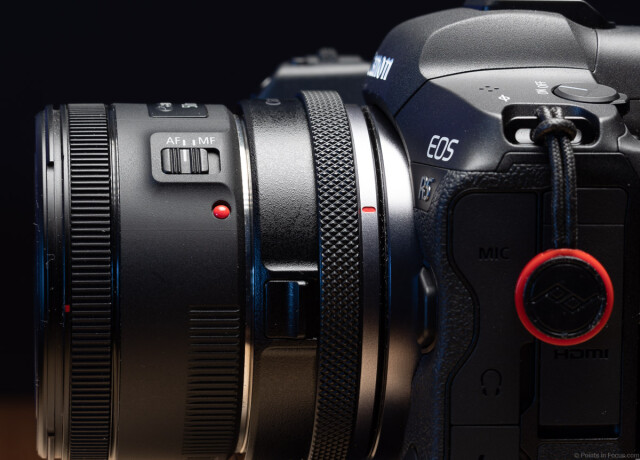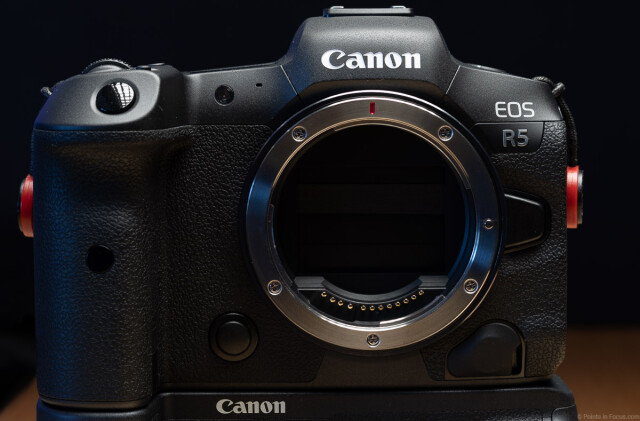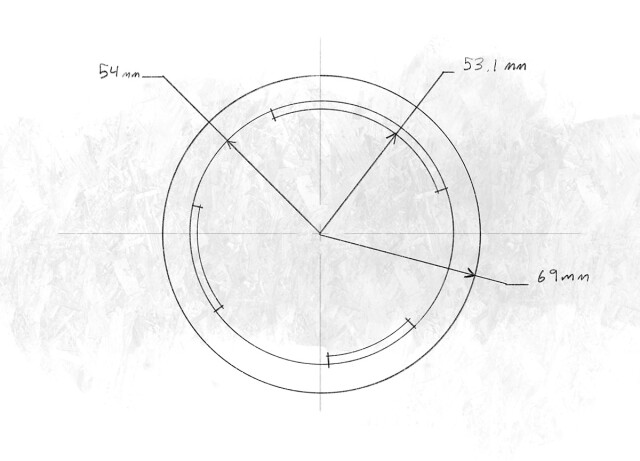Looking at the RF Mount form a Usability Perspective – EOS R5 Project Ep 5
Kicking off my in-depth review of the EOS R5, and the RF platform as a whole, I’m starting with the RF mount.
The RF mount combines features of Canon’s existing EF mount, with those of a mirrorless designs. It retains the EF mount’s 54mm throat diameter, but without a mirror, Canon reduced the flange-focal distance to 20mm.
The 20 mm flange-focal distance makes the RF mount the thickest full-frame mirrorless mount on the market. Compare this to Nikon’s Z-mount at 16 mm, and Sony’s E-mount at 18 mm. However, Canon clearly had more than just a mirrorless still lens mount in mind when they designed the RF mount.
To me, Nikon’s Z-mount seems to have gone too far in the wrong direction. Reducing the flange-focal distance is great for opening up lens design options. However, Nikon’s thin flange-focal distance required them to design a thinner shutter to even fit a mechanical shutter in their cameras. While thin might be good for lenses, I’m not sure the extra 2 mm was really worth it on the camera side. In addition, the thinness precludes things like integral ND filters should Nikon want to attempt to move into the video market as Canon and Sony have.
Sony’s E mount appears to suffer from some short sightedness in the diameter department. I know it’s been said, either by Sony themselves, or at least by Sony proponents, that the E-mount really was designed for full frame cameras; and Sony certainly has made it work for them. However, I find that hard to believe that was the intention from the start, in no small part because a full frame sensor’s corers are occluded by the mount, and it would have been trivial to increase the diameter to simplify that from the start.
However, with an 18 mm register, Sony’s E-mount video cameras have room for a novel ND solution; the electric ND filter. Based on my research, Sony’s electric ND filter uses LCD like technology to adjust applied neutral density, without having to move traditional glass lenses around in front of the sensor.
However, while electronic ND is a novel solution, it also introduces polarization due to how all liquid crystal systems work. Light is polarized before passing through the liquid crystal material. In response to the voltage applied to it, the liquid crystal twists altering the orientation of its polarization. When the polarization of the two layers is aligned, little light is blocked, and no ND is applied. As the crystal’s structure is twisted more, the two polarization planes are rotated further out of alignment, and less light is able to pass through.
Getting back to the RF mount.
As we saw with the Cinema EOS C70, by having a 20 mm flange-focal distance, Canon was able use a traditional glass ND filter pack between the mount and the sensor. This insures there’s no potential for unwanted side effects, and this wouldn’t be possible, or at least it would be substantially harder with a thinner flange-focal distance.
What are the down side of the 20mm flange-focal distance? As far as I can tell practically nothing.
According to a study done by Sony engineers, Canon’s RF mount doesn’t have any meaningful disadvantages in terms of the maximum theoretical aperture of a lens that can used. The RF mount can support a theoretical f/0.62 lens, compared to Sony’s E mount and Leica’s L mount at f/0.63, Nikon’s Z mount at f/0.58.
Though may sound as though Nikon has a huge advantage at f/0.58, it’s important to remember, in reality nobody is going build lenses anywhere near that fast. At least not in a practical, or accessible, price point. As things stand, Nikon’s manual focus only Z mount 58mm f/0.95 S Noct, is a bank breaking $8000, and even Canon’s f/1.2L primes, such as the RF 50mm f/1.2L USM or RF 85mm f/1.2L USM are $2300 and $2700 respectively.
My take on the mechanical aspects of the mount, is that while it’s a bit thicker than its counterparts, that aids it in being applicable in both the still photographer camera space and the video/cine camera space.
This brings me to the problems I have with the RF mount. Fortunately, as far as problems goes, these complaints are more niggles than deal breakers. More importantly, they’re not technical problems, as much as usability ones that can at least in part be addressed.
The first problem is less of a problem with the mount itself and more of a problem with an aesthetic design choice for RF lenses. Compared to EF lenses, there’s a decrease in usability in the mount alignment indicators.

On EF lenses, the alignment indicator is a fairly large, and tactile, red dot. While I might argue red isn’t the absolute best color, it’s not a bad one either. Either way, there’s reasonably good contrast between the red dot and the black or white body of EF lenses. This means it’s pretty easy to see the dot in most lighting conditions.
Which brings me to the second part of the EF alignment indicator; it’s tactile.
In those low light cases where you can’t readily see the dot, you can feel it. Even when it’s dark, you can still easily align and mount lenses. Find the dot with your thumb, orient that straight up toward the viewfinder bump, and you’re good to go mounting the lens.
What about the RF mount?
To start with Canon has made an aesthetic decision to have a gunmetal gray ring around the lens body at the lens mount. While this looks nice, it reduces the contrast between the red alignment indicator and the background of the lens body. Compared to the EF lenses, the reduction in contrast makes it more difficult to see the alignment indicator under more lighting conditions.
Compounding matters, the alignment indicator is now also smaller. Instead of a red circle, it’s a red line. Which again makes it harder to see, especially in lower light levels.
Finally, there’s the tactile aspect. Unlike EF lens’ raised dot, the RF lens indicator is inset. Additionally, all currently released RF mount lenses (except the teleconverters) have a raised body detail ahead of the mount indicator. Not only is it harder to feel the indicator in general, due to both its size and depth, but it’s harder to get your finger down to it in the first place due to the larger aesthetic design of the lenses.
I find it harder, under more lighting conditions, to index, and therefore mount, an RF lens than I do an EF lens.
The second problem with the RF mount is the way body and lens caps interact with the new locking lug pattern.

Unlike the EF mount, which used 3 radially symmetrical locking lugs, the RF mount uses 3 differently sized lugs. A large one at the top, a medium one in the 8 o’clock position, and small one in the 5 o’clock position.

Bayonet mount lenses only have at most 50% of the circumference is available for locking surfaces. However, the distribution of the locking surfaces has a practical influence on the mount’s ability to hold a lens in proper alignment against flexure. Ask a precision machinist, or toolmaker, and they’ll tell you that everything flexes if you’re measuring it with a precise enough tool.
Optical systems, especially ones stuck in front of high resolution sensors are more susceptible to image quality degradation due to this than cameras were in the past. Realistically most 35mm film stocks only had a digital equivalent resolution of 10 MP (often less), and even slow fine-grained films, only were the equivalent of 16-20 MP. Nobody designing lens mounts in the past imagined that their mount would be fit to the demands of 40+ MP digital cameras.
I suspect that the redistribution of locking surfaces on the RF mount was done to aid in strengthening the mount against flexure in the orientations it’s most likely to be a problem.
The large lug provides more structure to resist the outward pull of the lens when the camera is held horizontally. In conjunction with the small lug, provides strength against the pull of the lens when the camera is held vertically with the grip down.
Finally, the medium lug, provides the resistance against flexure when the camera is held vertically with the grip up.
At least, I suspect that’s the reasoning for the asymmetrical lugs.
That said, the downside of the asymmetry is that caps can no longer be attached in multiple orientations.
With an EF le ns, body and lens caps could be put on in any of 3 different positions, simply because of the symmetry of the mount. Now this didn’t mean you could mount the lens to the camera say upside-down, but when you’re talking about caps, unless you’re massively OCD, the orientation doesn’t matter. Consequently, not having to worry about orientation meant that it was much quicker and easier to put the caps on EF lenses and bodies, than it is with RF lenses and bodies.
With the RF mount, both the body and lens caps now can only be attached in one orientation. Admittedly, this isn’t a world ending problem, but it does make putting the caps on more fiddly than the EF mount, and maybe more fiddly than they really need to be.
That’s my look at the RF mount. I don’t see any immediately problematic design issues, and it appears to be broadly adaptable to both the needs of still cameras as well as digital video and cinema cameras. While there are some usability problems, as things currently stand, at least some of them can be addressed with slight changes to the lens’s cosmetic design going forward. As for the caps, well, that’s just something we’ll just have to get use to.
Comments
I recently swapped my RF cameras and lenses for R5s and RF. I wish I had read your article first. I shoot concerts and change lenses frequently in low light. I’m having a bear of a time lining things up. I have a very limited amount of time to shoot, and now I waste valuable, frustrating minutes trying to attach lenses. This decision was a serious folly, Canon.
I’m not looking for a hack or aftermarket solution to get me past this problem. I might use raised epoxy paint or stick on something that gives me back the contrasty, tactile feel.
Error above. It should start, “I recently swapped my EF cameras…”
One thing I’ve found that works for the lenses, is that the AF/MF switch tends to be in line with the mount alignment indicator. So far, I’ve found that gets me close enough that things go together quickly. Plus I usually find that I hold the lens near where the AF/MF switch anyway.
I actually still have a couple of EF lenses left, and I use the EF/RF adapter for them. This compounds the problem since there’s no visible “way up” on that thing. It’s a perfectly round ring with a tiny red dot hidden on each side and a very low contrast Canon logo on it.
My bane has become trying to add an EF teleconverter to my 400mm EF lens with the EF/RF adapter while I’m shooting in the dark. This was something that I did regularly with my 1Dx2, and I got pretty adept at doing it quickly.
In the meantime, I’ve added some silvery duct tape triangles to the lens barrels that point to the dots. Then I’ve ordered some tiny yellow “bump dots” for the visually impaired. I hope those work as a more permanent solution. I’d love to replace my 400 and two teleconverters, but that’s a seriously expensive proposition.
Thank you for including this folly of Canon’s in your article. I could not find mention of it anywhere else, which is surprising considering how serious it is.
If you’re not shooting a mix of DSLR and mirrorless at the same event, I’d just pick up a couple EF-EOS-R adapters and leave them permanently on the lenses you use most often. I mean compared to a 400/2.8L or even 400/4DO the mount adapters really aren’t that expensive.
Either way, thanks for reading and happy shooting.